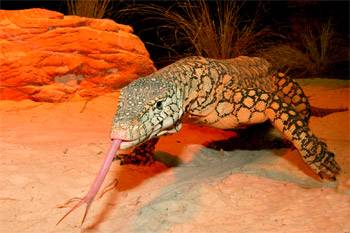Most Unknown Aussie Animal

Most Unknown Aussie Animal
As Aussies across the country prepare to celebrate all the great things about their nation, WILD LIFE Sydney Zoo is urging people to spare a thought for the rarely-recognised Aussie animals that call this great country home, including the Perentie – one of the world's largest lizard species, a title which is no mean feat.
The Perentie has taken out the mantle of -most unknown animal species' in research released today by WILD LIFE Sydney Zoo.
Keen to see some of Australia's weird-and-wonderful native fauna enjoy their time in the sun, WILDLIFE Sydney Zoo asked participants* to identify a list of eight lesser known animal species in Australia. The respondents (aged 17 – 60 years of age) were also challenged to say what they believed each name was referring to, before being informed that they were in fact animals that are native to Australia.
The top three creatures least known by participants were the Perentie (79%) and two species of mouse-like marsupials, the Rufous Bettong and the Fat-tailed Dunnart, both coming in at second (72%). Such was the mystery surrounding these animals that some of the participants identified Rufous Bettong as a -rugby player' and the Perentie as an -Italian sports car'.
What's more, while up to 37% of participants thought they knew what a Red-legged Pademelon was (59%), up to 27% said this adorable miniature-sized species of kangaroo was a -type of melon or fruit'. 14% of respondents also said that the Bilby was an -Easter chocolate bunny' rather than a real animal.
Will Meikle, Curator at WILD LIFE Sydney Zoo, said many Australians do not grasp the variety of weird and wonderful animals that inhabit Australia.
'From cute marsupials to flightless birds like Cassowaries, there are hundreds of unique Australian animals that deserve our attention but are seldom mentioned. One example of these lesser-known creatures is the Perentie, which is capable of growing up to a huge 2.5 metres. It is an astonishing five-fingered endurance hunter that can run very fast for long periods of time, unlike any other lizard species. As some of these animals are listed as threatened species, it's important that we turn our attention to other rarely seen but extraordinary animals in Australia aside from the iconic koala and kangaroo to help safeguard their existence."
Visitors can experience the ultimate Australian adventure at WILD LIFE Sydney Zoo this summer, walk through iconic Australian habitats and encounter some of the country's most loved, feared and lesser-known animals. From Thursday 19 December 2013 to Sunday 26 January 2014, young adventurers will also have the opportunity to explore the zoo with an Adventure Passport, collecting stamps along their journey through Australia to win a prize at the end.
Please see here for an interactive video putting kids' Aussie animal knowledge to the test: http://vimeo.com/83722646
|
|
Australia's most unknown animals (in order of the least known) Findings |
Fun facts |
|
1 |
The Perentie -79% |
One of Australia's largest lizards found in arid semi-desert and desert regions of central and western Australia, it has a forked tongue like a snake which can pick up scents from the air. |
|
2 |
Rufous Bettong - 72% |
Common on the north east coast of Australia, the Rufous Bettong carries nesting material on its prehensile tail to make a conical grass nest. |
|
2 |
Fat-tailed Dunnart - 72% |
This mouse sized marsupial is widespread across a large part of Australia in a variety of habitats, and can store fat in the base of its tail. |
|
3 |
Pademelon - 63% |
Small wallabies found in the coastal forests of Eastern Australia with a relatively short tail and legs to aid its movement through dense vegetation. The name Pademelon is of aboriginal derivation. |
|
4 |
Spotted-tailed Quoll - 45% |
Nocturnal, sheltering in hollow logs or rock crevices, the Quoll is a marsupial found in forests and rainforests on the east coast of Australia, including Tasmania, but habitat loss and competition with introduced predators have contributed to a substantial reduction in its species. |
|
5 |
Spinifex Hopping Mouse - 54% |
Found in central desert areas of Australia, it is characterized by its hopping gait and long brush-tipped tail to maintain balance. It has no need for water as it obtains sufficient water from its diet of seeds, roots and insects. |
|
6 |
Bilby - 28% |
Unmistakable due to its long ears and silky blue-grey fur, this nocturnal bandicoot sleeps in a deep burrow during the day. They obtain sufficient water from their food to make drinking freestanding water unnecessary. Changes in land-use and the impact of foxes and cats have drastically reduced their range. |
|
7 |
Cassowary - 27% |
Cassowaries are one of only a few species that is able to disperse large rainforest fruits over long distances. By doing so, they play an essential role in maintaining the diversity of the Wet Tropics in Far North Queensland. Without cassowaries, the rainforest would gradually change and become less diverse. |
For more information, please visit: www.wild-life.com.au
MORE





